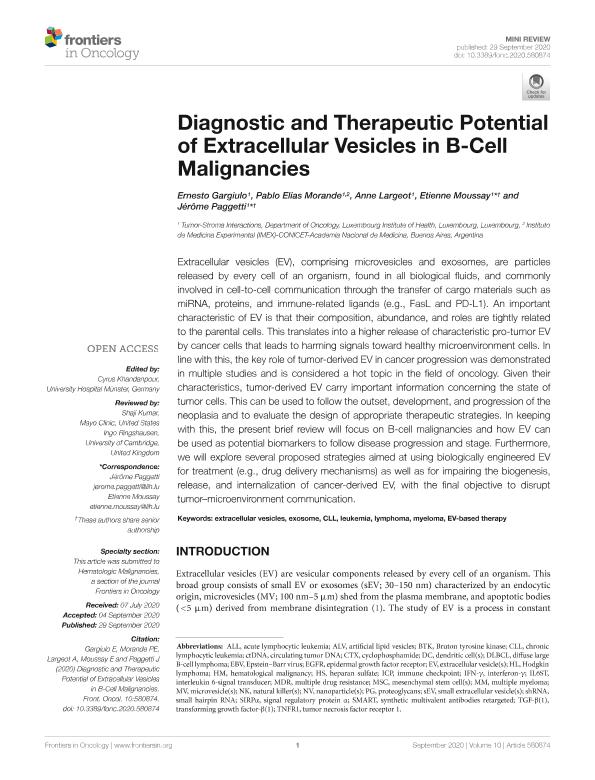Mostrar el registro sencillo del ítem
dc.contributor.author
Gargiulo, Ernesto
dc.contributor.author
Morande, Pablo Elías

dc.contributor.author
Largeot, Anne
dc.contributor.author
Moussay, Etienne
dc.contributor.author
Paggetti, Jérôme
dc.date.available
2021-11-09T15:46:10Z
dc.date.issued
2020-09
dc.identifier.citation
Gargiulo, Ernesto; Morande, Pablo Elías; Largeot, Anne; Moussay, Etienne; Paggetti, Jérôme; Diagnostic and Therapeutic Potential of Extracellular Vesicles in B-Cell Malignancies; Frontiers Media; Frontiers in Oncology; 10; 580874; 9-2020; 1-9
dc.identifier.issn
2234-943X
dc.identifier.uri
http://hdl.handle.net/11336/146448
dc.description.abstract
Extracellular vesicles (EV), comprising microvesicles and exosomes, are particles released by every cell of an organism, found in all biological fluids, and commonly involved in cell-to-cell communication through the transfer of cargo materials such as miRNA, proteins, and immune-related ligands (e.g., FasL and PD-L1). An important characteristic of EV is that their composition, abundance, and roles are tightly related to the parental cells. This translates into a higher release of characteristic pro-tumor EV by cancer cells that leads to harming signals toward healthy microenvironment cells. In line with this, the key role of tumor-derived EV in cancer progression was demonstrated in multiple studies and is considered a hot topic in the field of oncology. Given their characteristics, tumor-derived EV carry important information concerning the state of tumor cells. This can be used to follow the outset, development, and progression of the neoplasia and to evaluate the design of appropriate therapeutic strategies. In keeping with this, the present brief review will focus on B-cell malignancies and how EV can be used as potential biomarkers to follow disease progression and stage. Furthermore, we will explore several proposed strategies aimed at using biologically engineered EV for treatment (e.g., drug delivery mechanisms) as well as for impairing the biogenesis, release, and internalization of cancer-derived EV, with the final objective to disrupt tumor–microenvironment communication.
dc.format
application/pdf
dc.language.iso
eng
dc.publisher
Frontiers Media

dc.rights
info:eu-repo/semantics/openAccess
dc.rights.uri
https://creativecommons.org/licenses/by-nc-sa/2.5/ar/
dc.subject
CLL
dc.subject
EV-BASED THERAPY
dc.subject
EXOSOME
dc.subject
EXTRACELLULAR VESICLES
dc.subject
LEUKEMIA
dc.subject
LYMPHOMA
dc.subject
MYELOMA
dc.subject.classification
Inmunología

dc.subject.classification
Medicina Básica

dc.subject.classification
CIENCIAS MÉDICAS Y DE LA SALUD

dc.title
Diagnostic and Therapeutic Potential of Extracellular Vesicles in B-Cell Malignancies
dc.type
info:eu-repo/semantics/article
dc.type
info:ar-repo/semantics/artículo
dc.type
info:eu-repo/semantics/publishedVersion
dc.date.updated
2021-08-27T20:25:48Z
dc.identifier.eissn
2234-943X
dc.journal.volume
10
dc.journal.number
580874
dc.journal.pagination
1-9
dc.journal.pais
Suiza

dc.journal.ciudad
Lausanne
dc.description.fil
Fil: Gargiulo, Ernesto. Luxembourg Institute of Health; Luxemburgo
dc.description.fil
Fil: Morande, Pablo Elías. Luxembourg Institute of Health; Luxemburgo. Consejo Nacional de Investigaciones Científicas y Técnicas. Instituto de Medicina Experimental. Academia Nacional de Medicina de Buenos Aires. Instituto de Medicina Experimental; Argentina
dc.description.fil
Fil: Largeot, Anne. Luxembourg Institute of Health; Luxemburgo
dc.description.fil
Fil: Moussay, Etienne. Luxembourg Institute of Health; Luxemburgo
dc.description.fil
Fil: Paggetti, Jérôme. Luxembourg Institute of Health; Luxemburgo
dc.journal.title
Frontiers in Oncology
dc.relation.alternativeid
info:eu-repo/semantics/altIdentifier/url/https://www.ncbi.nlm.nih.gov/pmc/articles/PMC7550802/
dc.relation.alternativeid
info:eu-repo/semantics/altIdentifier/doi/http://dx.doi.org/10.3389/fonc.2020.580874
dc.relation.alternativeid
info:eu-repo/semantics/altIdentifier/url/https://www.frontiersin.org/articles/10.3389/fonc.2020.580874/full
Archivos asociados
